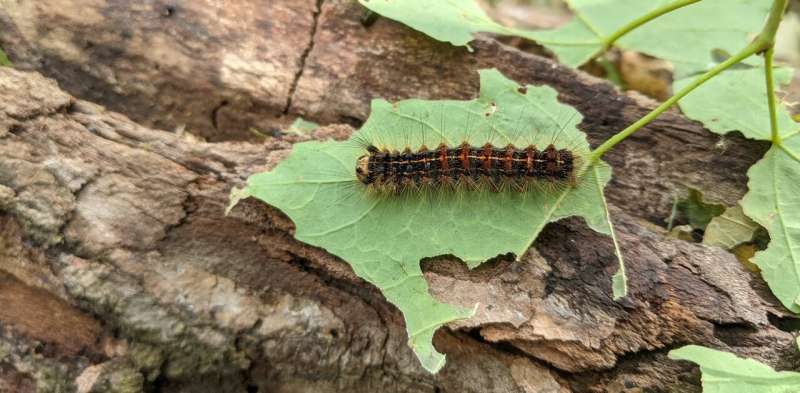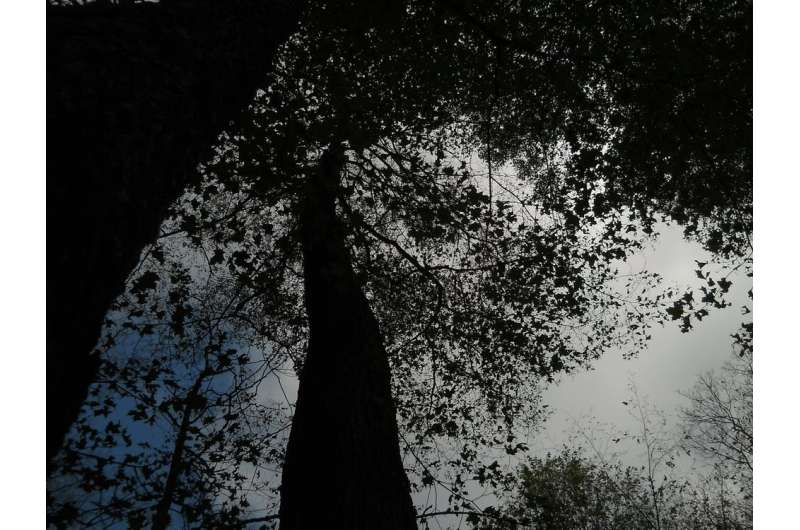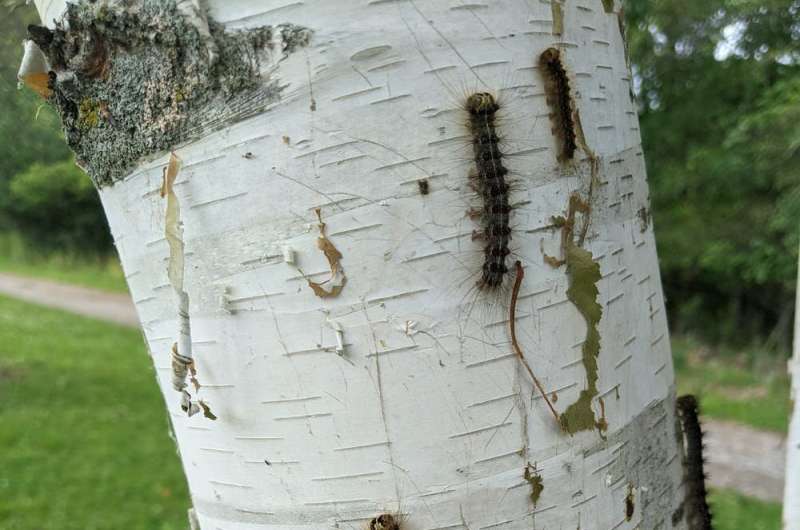Efforts to manage the invasive caterpillar L. dispar have cost billions of dollars in Canada and the United States. Credit: Chris MacQuarrie, Author provided
The past several weeks have seen a voracious moth caterpillar eat its way through tree leaves across southern Ontario and Québec, and from Michigan to Vermont.
Since the 1980s, Lymantria dispar has led to enormous outbreaks, often lasting multiple years. The caterpillar has caused a great deal of damage, totalling more than 17,000 square kilometres across Canada. Efforts to manage the insect have cost billions of dollars in both Canada and the United States.
The common name of this insect (gypsy moth) is problematic, so I'll refer to it as L. dispar. You might also see it called "LDD moth" in some reports. They're all the same species.
So folks on here may have been inundated with talk about Lymantria dispar dispar, (the Gypsy moth) given the outbreak in Ontario and the US North east. But where does that common name come from? We'll I've done some digging and found out...
— Chris MacQuarrie (@CMacQuar) June 28, 2021
L. dispar can be traced back to one man's failed business venture, in this case, an attempt to launch a North American silk industry more than a century ago. Although it remains limited to a handful of provinces and U.S. states, the invasive species could spread further with global warming.
Failed business, but successful invasive species
Étienne Léopold Trouvelot, a French artist, astronomer and entomologist, was living in Medford, Mass., in the late 1800s when he decided to start breeding native North American moths in the trees near his house to create a silkworm colony. He was unsuccessful, probably because his caterpillars contracted viral diseases when they were kept in large numbers. Birds kept eating his caterpillars too.
Trouvelot's solution was to import a European caterpillar he would breed with his North American caterpillars to create a cross that was resistant to disease and difficult for birds to eat. The caterpillar he chose was L. dispar.
Trouvelot's L. dispar got away from him one day in 1868 or 1869 when the young caterpillars escaped from his home laboratory. By 1879 the residents of Medford began to complain about large numbers of unfamiliar caterpillars infesting their trees.
Trees in the Thornton Bales Conservation Area near King City, Ont., defoliated by L. dispar during the 2021 outbreak. Credit: Chris MacQuarrie, Author provided
One neighbour wrote: "The caterpillars were over everything in our yard and stripped all our fruit trees, taking the apple trees first and then the pears. There was a beautiful maple on the street in front of the next house, and all its leaves were eaten by the caterpillars. They got from the ground upon the house and blackened the front of it. … The caterpillars would get into the house in spite of every precaution, and we would even find them upon the clothing hanging in the closets."
The first efforts to control L. dispar were labour intensive. This was the era before the development of most chemical insecticides and so labourers would be sent into the trees to remove the insects. But this did not limit the spread of the infestation, and over the next years L. dispar spread westward, eventually crawling their way into southern Québec and Ontario in the late 1960s.
Caterpillar poop underfoot and on your head
Ontario has experienced three L. dispar outbreaks since the 1980s. The biggest one in the 1990s, affected almost 350,000 hectares of forest. That was until 2020 when 585,000 hectares, an area roughly the size of Prince Edward Island, were recorded as damaged by L. dispar.
L. dispar's massive appetite is what makes it a big problem. One caterpillar can consume a square metre of leaves as it grows (an area about the size of bath towel). Multiply this by millions or billions of caterpillars all eating at the same time and forests can quickly become defoliated.
As the caterpillars eat, they poop, raining small particles called frass onto the forest floor—or any unfortunate person sitting below.
L. dispar is also not fussy about what it eats. It prefers oaks, but also eats maple, birch and aspen, and other plants. Most trees can tolerate this defoliation and so the insect rarely kills trees outright.
But repeated damage can leave trees open to being killed by other causes. One recent study found a decrease in young oak trees in U.S. forests that experienced more L. dispar outbreaks.
L. dispar can kill some conifers, like white pine and balsam fir, when it consumes the needles of these trees, because unlike deciduous trees, conifers can't regrow their needles.
L. dispar caterpillars make their way up the trunk of a birch tree at the Royal Botanical Gardens Arboretum in Burlington, Ont. Credit: Chris MacQuarrie, Author provided
Burlap caterpillar traps
Managing L. dispar can be challenging. Some municipalities spray trees with a biological insecticide called BtK that targets caterpillars specifically. These spray programs happen in the early summer when the caterpillars are small and the most susceptible to the insecticide.
Homeowners can also apply BtK to trees in the spring to reduce the number of caterpillars on their trees. Another approach is to wrap a band of burlap around the trunk of the tree to catch the caterpillars as they move up and down the tree during the day.
These burlap wraps can then be disposed of in a bucket of soapy water. In the late summer and fall the spongy egg masses can be scraped off and disposed of too. This tactic is also useful at preventing the spread of L. dispar, as the egg masses can be transported on vehicles and outdoor equipment.
Insect pandemics
When will it end? Outbreaks of L. dispar last three to five years and usually end on their own. The insects are susceptible to a virus and a fungus that cause epizootics—insect pandemics—that kill huge numbers of caterpillars.
Between insect outbreaks, the virus and the fungus, along with predators, keep the populations small. The same virus is also possibly the reason that outbreaks of the insect occur at regular intervals of five to 10 years.
The insect's range is, right now, limited to Ontario, Québec and the Maritimes, but climate change is predicted to increase the area in Canada where L. dispar can successfully establish. By 2050, as carbon dioxide levels increase and temperatures rise, it could be distributed across much of the country, from southern Alberta to Nova Scotia. British Columbia's steep mountains and cold alpine climate will hold back the insect.
Invasive species are a persistent threat to the forests of North America, but one that can be lost in the background of more visible threats like wildfire and climate change. This threat, however, is one that most people can do something about to help prevent the introduction and spread of new species, such as not moving firewood from one region to another.
L. dispar is here to stay, but we can help make sure that we don't introduce any more of its friends!
Provided by The Conversation
This article is republished from The Conversation under a Creative Commons license. Read the original article.![]()























